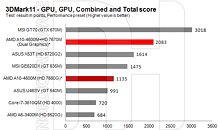Wednesday, April 25th 2012

AMD A10-4600M Performance Revealed in Infographic
AMD revealed performance numbers of its key product for mainstream notebooks, the A10-4600M, in an infographic for the Korean market. Besides detailing the part, it reveals some performance numbers. To begin with, A10-4600M is based on the 32 nm "Trinity" silicon with all its components enabled. It has four x86-64 cores spread across two "Piledriver" architecture modules, 4 MB of total cache (2x 2 MB), CPU clock speeds of 2.30 GHz (3.00 GHz TurboCore), and integrated Radeon HD 7660G graphics that has 384 VLIW4 stream processors, and GPU core speed of 685 MHz. The chip integrates a PCI-Express 2.0 root complex, and dual-channel DDR3-1600 MHz integrated memory controller.
Moving on to performance numbers, and as expected, the infographic doesn't touch comparative CPU performance with a barge-pole. Instead the focus is on graphics performance, with an emphasis on Dual GPU feature, where the integrated graphics can work in tandem with a discrete GPU of the same class, resulting in up to 75% performance increase. Based on data from this infographic, and its own testing data of other notebooks, NordicHardware compiled relative performance of the IGP and Dual Graphics setup involving the A10-4600M and Radeon HD 7670M discrete GPU.
Source:
NordicHardware.se
Moving on to performance numbers, and as expected, the infographic doesn't touch comparative CPU performance with a barge-pole. Instead the focus is on graphics performance, with an emphasis on Dual GPU feature, where the integrated graphics can work in tandem with a discrete GPU of the same class, resulting in up to 75% performance increase. Based on data from this infographic, and its own testing data of other notebooks, NordicHardware compiled relative performance of the IGP and Dual Graphics setup involving the A10-4600M and Radeon HD 7670M discrete GPU.




31 Comments on AMD A10-4600M Performance Revealed in Infographic
1: Dual GPU on a laptop is a dumb idea. The power usage of APU + retarded discrete GPU (rdGPU) is the same as pwoer usage of CPU (with no iGPU) + decent discrete GPU. The performance of ddGPU is much better and unlike rdGPU there are no CrossFire issues with driver support, weird performance drops, microstuttering etc. On top of that it is easier to cool two distinct components that both use roughly as much power, than to chill an unbalanced pair. Besides ddGPUs of today use astonishingly low amounts of power in 2D mode so there are no upsides to using APU + rdGPU in a laptop, only downsides.
It might be a different matter on a desktop where one might want to risk the small amount of money in hopes of getting better graphics performacne but not going all the way and splurging for a HD7750, but this article is about laptops.
2: Since Trinity dumped the braindead L3 cache of Bulldozer I take it's going to use less power for same performance level and suffer less from context switches due to "dumb schedulers" (it's always somebody else's fault when one's product doesn't perform well, right AMD ?). Is this a reasonable assumption or does the increased memory latency outweigh the benefits of getting rid of L3 ?
1. No the power cosumption is still less since you can switch off the discrete completely.
how less? an 6550G + 7450 on dirt 3 will last around 2hrs.
i played dirt 3 on that combo and it drained 20% of the battery after a little more than 20mins of play.
True the microstuttering is existent, but thats only a driver issue that needs time to be solved.
and power consumption is soooo low you will be amazed.
also contrary to what you think, its easier to cool an APU than two discrete things, since you need only one heat collection area, thereby making the laptop a lot lighter by eliminating heatsink weight.
i can use the apu powered lappy and game/stress on it, with it on my lap, without burning my thighs. Contrary an Atom gave me 1st degree burns while i was reinstalling its OS
true their CPU performance sucks, but the graphics and the cheap is more than good enough for most people.
he just wants to bitch about it aka be the troll he is like a few other users here. APUs design was a good Media CPU and a stronger graphics core
^Got the Passmark stuff for A10-4600M 7660G graphics only though before it was deleted
A8-3870K GPU had 2 GB @ 1333 MHz
A10-4600M GPU had 1 GB @ 800 MHz
(both were 128 bit)
I just realize that my Bus Speed never goes higher than 100mhz, my multipler goes to 23 that has no issues, but it's the Bus Speed that won't go to 200mhz, any ideas why?
thanks in advance